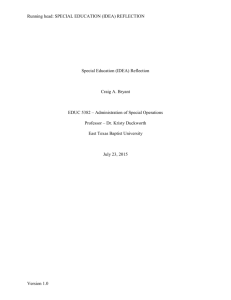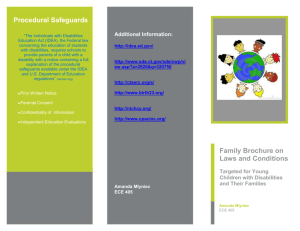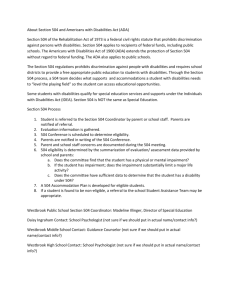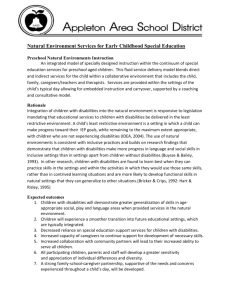Family Brouchure
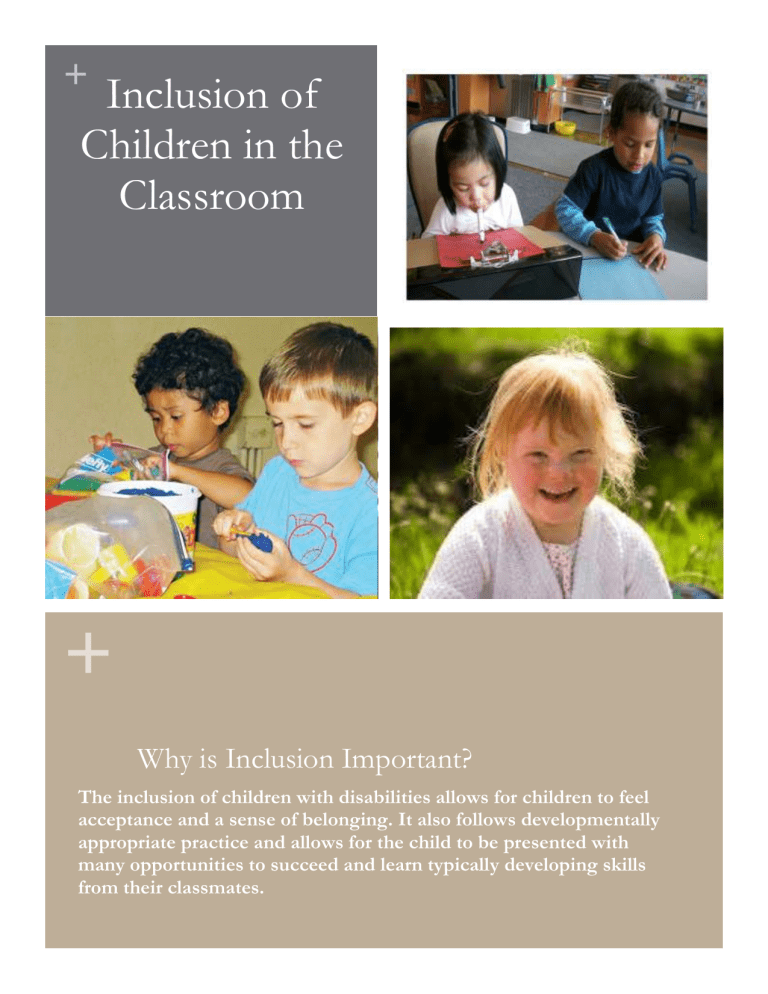
+
Inclusion of
Children in the
Classroom
+
Why is Inclusion Important?
The inclusion of children with disabilities allows for children to feel acceptance and a sense of belonging. It also follows developmentally appropriate practice and allows for the child to be presented with many opportunities to succeed and learn typically developing skills from their classmates.
2
+
An Inclusive Environment
In an inclusive environment, the child has total access to the curriculum and all the activities that are carried out in the classroom.
The children have just as equally the chance to participate in everything as children with no disabilities. There are plenty support services that are available for the child, care providers and the staff to help meet the individual needs of the child. All the goals that the child hopes to achieve are met in the early childhood setting at the greatest extent possible.
+
The Americans With Disabilities Act
The ADA prohibits discrimination against people with disabilities in all settings. It assures civil rights to those with make accommodations to meet individual child needs.
Make accommodations means that the center will apply adaptations to help disabilities. It also assures rights for including access make sure every child will succeed to the best that to accommodations in child they can.
care and preschool settings.
The ADA states that child care centers cannot discriminate against children or parents with special needs and prices can not be any higher than it would be for a typically developing child. The centers must be willing to
3
+
Individuals with Disabilities Education Act
4
The IDEA helps provide special education opportunities. It requires states to provide FAPE in the LRE.
It strengthens inclusion for infants, toddlers and preschoolers.
The FAPE is the Free Appropriate
Public Education. This states that children with disabilities are entitled to the same educational experience as non-disabled peers.
The LRE is the Least Restrictive
Environment. This states that children with disabilities are entitled to the same educational experience as non-disabled peers.
+
Individual Education Plan
(IEP) and Individualized
Family Service Plan (IFSP)
If your child has disabilities than they may be eligible for special education and related services. If and when a child meets the needs of special services then an IEP would be developed for them. The IEP lays out plans to achieve goals and objectives. The IEP is set up through a team, which includes the teacher, care givers and specialists. If the child is under three years old and requires special education than the IFSP guides early intervention for the child.
Both of these opportunities set up goals that are connected to the child’s care facility.
5
+
Time of laws and changes
1965 : Congress adds Title VI to the Elementary and Secondary Education Act of
1965 creating a Bureau of Education for the Handicapped (this bureau today is called the Office of Special Education Programs or OSEP).
972: Two significant supreme court decisions [PARC v. Pennsylvania (1972) and
Mills v. D.C. Board of Education (1972)] apply the equal protection argument to students with disabilities.
1973: Section 504 of the Rehabilitation Act of 1973 is enacted into statute. This national law protects qualified individuals from discrimination based on their disability.
1974: The Family Educational Rights and Privacy Act (FERPA) is enacted.
1975: The Education for All Handicapped Children Act (EAHCA) is enacted. This was also known as P.L. 94-142. Today we know this law as the Individuals with
Disabilities Education Act (IDEA).
1977: The final federal regulations of EAHCA are released.
1986: The EAHCA is amended with the addition of the Handicapped
1990: The Americans with Disabilities Act (ADA) is enacted.
1997: IDEA reauthorized
2001: No Child Left Behind is enacted.
2004: IDEA reauthorized
6
+
P.L. 94 – 142.
This guaranteed free appropriate public education to each child with a disability. There are four purposes.
Purpose 1.
To make sure that children with disabilities are able to access a free appropriate public education which highlights special education and any extra
Purpose 3.
Assist places in providing education for all children with disabilities.
Purpose 4.
Make sure that the efforts to educate children with disabilities are effective.
7
+
Additional
Information
+ http://www.weac.org/Issues_Advocacy/Resource_Pages_On_Issues_one/Special_Educ ation/special_education_inclusion.aspx
http://www.childaction.org/families/publications/docs/guidance/Handout48-
Caring_For_Children_With_Special_Needs.pdf http://unesdoc.unesco.org/images/0018/001831/183156e.pdf
http://www.ada.gov/ http://www.brighthubeducation.com/special-ed-inclusion-strategies/66803-brief-legalhistory-of-inclusion-in-special-education/
